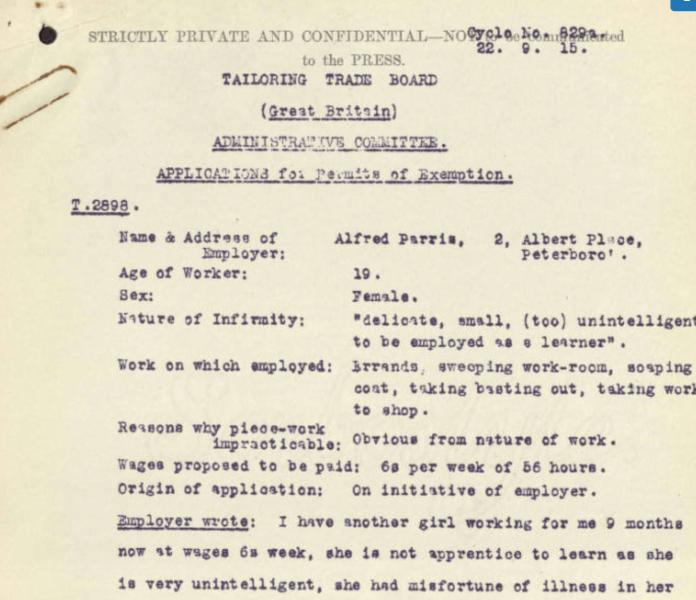
Employment levels for people with learning disabilities in the UK are 5 to 10 times lower than they were a hundred years ago. And the experiences of workers from the 1910s–50s offer inspiration as well as lessons about safeguarding.
Employment levels for people with learning disabilities in the UK are 5 to 10 times lower than they were a hundred years ago. And the experiences of workers from the 1910s–50s offer inspiration as well as lessons about safeguarding.
We need to have more bold ambition and stop being content with really marginal forms of inclusion
Lucy Delap
A new study by historian Professor Lucy Delap (Murray Edwards College) argues that loud voices in the 20th-century eugenics movement have hidden a much bigger picture of inclusion in British workplaces that puts today’s low rates to shame.
Professor Delap found that in some parts of Britain, up to 70% of people variously labelled ‘defective’, ‘slow’ and ‘odd’ at the time had paid jobs when demand for labour was high, including during and after the First World War. This proportion fell during recessions, but even then, 30% remained in work. By contrast, in the UK today less than 5% of adults with intellectual disabilities are employed.
“A recession now couldn’t make levels of employment of people with learning disabilities much worse, they are on the floor already,” Professor Delap says. Her study, published in the journal Social History of Medicine follows a decade of painstakingly piecing together evidence of people with learning disabilities in the British workforce in the first half of the 20th century.
Delap found no trace in employers’ records or in state archives which focused on segregation and detaining people. But she struck gold in The National Archives in Kew with a survey of ‘employment exchanges’ undertaken in 1955 to investigate how people then termed ‘subnormal’ or ‘mentally handicapped’ were being employed. She found further evidence in the inspection records of Trade Boards now held at Warwick University’s Modern Records Centre. In 1909, a complex system of rates and inspection emerged as part of an effort to set minimum wages. This led to the development of ‘exemption permits’ for a range of employees not considered to be worth ‘full’ payment.
Delap says: “Once I found these workers, they appeared everywhere and not just in stereotypical trades like shoe repair and basket-weaving. They were working in domestic service, all kinds of manufacturing, shops, coal mining, agriculture, and local authority jobs.”
Delap’s research goes against most previous writing about people with intellectual disabilities which has focused on eugenics and the idea that preindustrial community inclusion gave way to segregation and asylums in the nineteenth century. “We've been too ready to accept that narrative and haven’t gone looking for people in the archive,” Delap says. “Many weren’t swept up into institutions, they lived relatively independent lives, precarious lives, but often with the support of families, friends and co-workers.”
‘Wage age’ versus IQ
Previous studies have focused on the rise of IQ testing in this period, but the employment records that Delap studied showed something very different: a more positive sense of ability couched in terms of the wages someone was worth. This involved imagining a person’s ‘wage age’, meaning that an adult worker could begin with a starting age of 14 and advance in wage age through their working life. Not everyone did advance though.
Delap says “The idea of ‘wage age’ was harsh in many ways but it was far less stigmatising than IQ which emphasised divisions between ‘normal’ and ‘defective’ and suggested people couldn’t advance beyond a certain point. By contrast, ideas of fairness, productivity and ‘the going rate’ were deployed to evaluate workers. When labour was in demand, workers had leverage to negotiate their wage age up. IQ didn't give people that power.”
Appeal to employers
Under the exemption system, employers saw the business case for employing – usually at a significantly lower rate of pay – loyal workers who could be trusted to carry out routine tasks.

Delap says: “If anything, governments gave signals that these people shouldn't be employed, that they were better off under the care and control of the mental deficiency boards. But employers understood that they could be good workers.”
In 1918, an ‘odd job’ worker employed for 20 years at a London tin works was described as suffering from ‘mental deficiency’ and didn’t know the time of the year or who Britain was fighting. Nevertheless, in the inspector’s opinion, he was ‘little if at all inferior to an ordinary worker of full capacity’ on the hand press and ‘His speed at cutting out on an unguarded fly machine was noticeable.’ His employer agreed to a raise from 18 to 24 shillings a week, just below what a carter could earn.
Employer calculations, Delap emphasises, fluctuated with the state of the labour market. When workers were in short supply, those with learning disabilities became more attractive. When demand for labour fell these workers might be the first to lose their jobs.
Were employers just exploiting vulnerable workers?
Delap found clear evidence of some workers being exploited, being stuck on the same very low wage and the same monotonous task for years.
“We shouldn’t feel nostalgic, this wasn’t a ‘golden age’ of disability-friendly employment,” Delap says. And yet, the archive reveals a strong reciprocal sense of real work being done and wages being paid in exchange. “Many of these people would have considered themselves valued workers and not charity cases. Some were able to negotiate better conditions and many resisted being told to do boring, repetitive work.”
Delap repeatedly encountered families policing the treatment of their relative. In 1922, the owner of a laundry in Lincolnshire considered sacking a 25-year-old ‘mentally deficient’ woman who starched collars because ‘trade is so bad’ but kept her on ‘at request of her parents’. “Workers who had families looking out for them were more able to ask for wage rises, refuse to do certain jobs and limit exploitation,” Delap says. “I found lots of evidence of love and you don't often see that in archives of intellectual disability.”
Parents or siblings sometimes worked on the same premises which, Delap argues, strengthened the bonds of moral obligation that existed between employers and families. In 1918, for instance, a 16-year-old who attached the bottoms of tin cans in Glamorgan was hired ‘for the sake of her sisters who are employed by the firm and are satisfactory workers’.
Lessons for today
Delap sees concerning similarities between the 1920s and the 2020s in terms of how British institutions manage, care for and educate people with learning disabilities.
Historically, Delap argues, institutions were just stop-gaps, places where people could be kept without onward pathways. People were often not trained at all or trained to do work that didn't really exist like basket-weaving. “This remains a problem today,” Delap says. “We have a fast-changing labour market and our special schools and other institutions aren’t equipping people well enough for viable paid opportunities.”
Delap argues that evidence of people with learning disabilities successfully working in many different roles and environments in the past undermines today’s focus on a very narrow range of job types and sectors. She highlights the fact that many workers with learning disabilities used to be involved in the service sector, including public facing roles, and not just working in factories. “They were doing roles which brought them into contact with the general public and being a service sector economy today, we have lots of those jobs.”
Delap also believes that structural factors continue to prevent people from accessing jobs. “Credentialism has made it very difficult for people don’t have qualifications to get jobs which they might actually be very good at,” she says. “We need to think much harder about how we make the system work for people with a range of abilities. I also think the rise of IT is a factor, we haven’t been training people with learning disabilities well enough in computer skills so it has become an obstacle.”
Delap believes that Britain’s ageing population and struggle to fill unskilled jobs means there is a growing economic as well as a moral case for employing more people with learning disabilities.
She points out that many people with intellectual disabilities used to work in agriculture, a sector now facing chronic labour shortages. Delap acknowledges that exploitation remains a problem in agriculture, so safeguarding would be paramount, as it would be in every sector.
“I think employers are recognising that they need active inclusion strategies to fill vacancies and that they need to cultivate loyalty,” Delap says. “Work remains a place where we find meaning in our lives and where we make social connections and that's why so many people with disabilities really want to work and why it deprives them of so much when they are excluded. We need to have more bold ambition and stop being content with really marginal forms of inclusion.”
Reference
L Delap, ‘Slow Workers: Labelling and Labouring in Britain, c. 1909–1955’, Social History of Medicine (2023). DOI: 10.1093/shm/hkad043

The text in this work is licensed under a Creative Commons Attribution-NonCommercial-ShareAlike 4.0 International License. Images, including our videos, are Copyright ©University of Cambridge and licensors/contributors as identified. All rights reserved. We make our image and video content available in a number of ways – as here, on our main website under its Terms and conditions, and on a range of channels including social media that permit your use and sharing of our content under their respective Terms.




